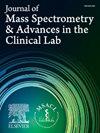电感耦合等离子体质谱法(ICP-MS)分析红细胞中镁、铜和锌的方法验证。
IF 3.4
4区 医学
Q2 MEDICAL LABORATORY TECHNOLOGY
Journal of Mass Spectrometry and Advances in the Clinical Lab
Pub Date : 2024-10-13
DOI:10.1016/j.jmsacl.2024.10.003
引用次数: 0
摘要
背景:红细胞(RBC)中镁(Mg)、铜(Cu)和锌(Zn)等微量元素的实验室测量对于评估营养状况和诊断金属中毒至关重要。本研究的目的是开发并验证一种 ICP-MS 方法,用于定量检测红细胞中的这些元素:方法:等分包装好的红细胞,用含有内标、0.1 % Triton X-100、0.1 % EDTA 和 1 % 氢氧化铵的碱性稀释液稀释。稀释后的样本使用电感耦合等离子体质谱法(ICP-MS)进行分析,以定量测定镁、铜和锌的含量。该方法经过了准确度、精密度、方法比较、线性度、分析灵敏度和携带率的验证。此外,还对回顾性数据进行了分析,并计算了非参数参考区间:结果:所有分析物的准确度和线性度均在预期范围内(≤±15%)。运行内、运行间和总不精密度的变异系数均小于 15%。所有其他验证实验均符合既定的验收标准。使用该方法对患者样本进行了回顾性数据分析。采用 Tukey's HSD 检验进行多重比较,结果显示平均差异有显著统计学意义(p 结论:该方法成功地验证了 "雌激素水平 "和 "雌激素水平":该方法已成功通过验证,并符合临床使用标准。对患者结果的回顾性数据分析表明,该方法适用于评估营养缺乏和毒性。本文章由计算机程序翻译,如有差异,请以英文原文为准。
Method validation of an inductively coupled plasma mass spectrometry (ICP-MS) assay for the analysis of magnesium, copper and zinc in red blood cells
Background
Laboratory measurements of trace elements such as magnesium (Mg), copper (Cu), and zinc (Zn) in red blood cells (RBCs) are essential for assessing nutritional status and diagnosing metal toxicity. The purpose of this study was to develop and validate an ICP-MS method for quantifying these elements in RBCs.
Methods
Packed RBCs were aliquoted and diluted in an alkaline diluent solution containing internal standards, 0.1 % Triton X-100, 0.1 % EDTA, and 1 % ammonium hydroxide. The resulting diluted specimen was analyzed using inductively coupled plasma mass spectrometry (ICP-MS) to quantitatively determine the levels of Mg, Cu, and Zn. The method underwent validation for accuracy, precision, method comparison, linearity, analytical sensitivity, and carryover. Additionally, retrospective data were analyzed, and non-parametric reference intervals were calculated.
Results
Accuracy and linearity fell within the expected range of ≤±15 % for all analytes. Within-run, between-run, and total imprecision were ≤15 % coefficient of variation. All other validation experiments met the established acceptance criteria. Retrospective data analysis was conducted on patient samples using the method. The application of Tukey’s HSD test for multiple comparisons revealed statistically significant mean differences (p < 0.05) in Mg, Cu, and Zn concentrations between all pairwise groups of age and sex, except for the mean Cu concentration in adult males versus females and the mean Mg concentrations in adult versus minor males.
Conclusions
The presented method was successfully validated and met the criteria for clinical use. Retrospective data analysis of patient results demonstrated the method’s suitability for assessing nutritional deficiency and toxicity.
求助全文
通过发布文献求助,成功后即可免费获取论文全文。
去求助
来源期刊

Journal of Mass Spectrometry and Advances in the Clinical Lab
Health Professions-Medical Laboratory Technology
CiteScore
4.30
自引率
18.20%
发文量
41
审稿时长
81 days
 求助内容:
求助内容: 应助结果提醒方式:
应助结果提醒方式:


